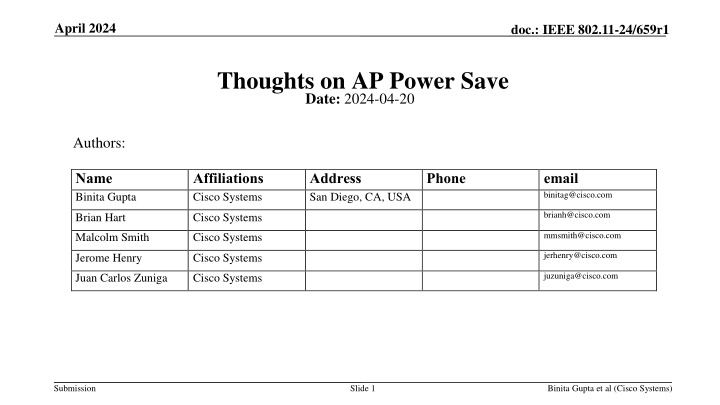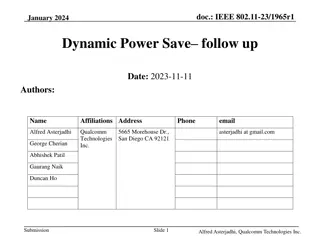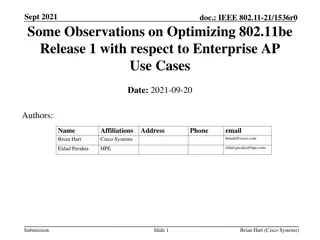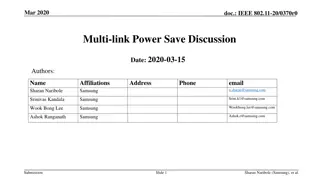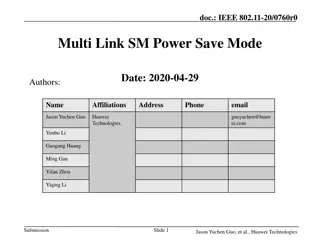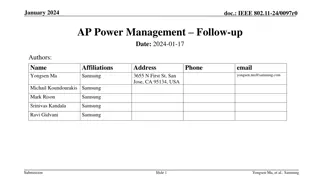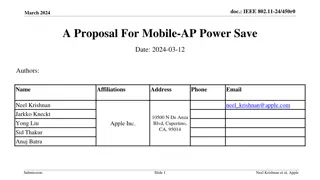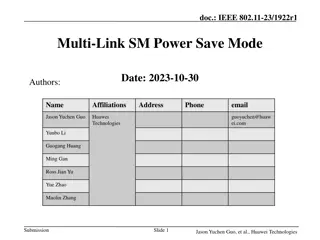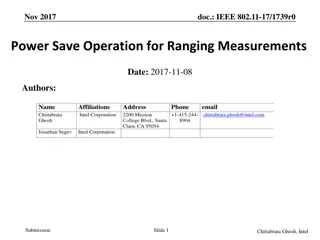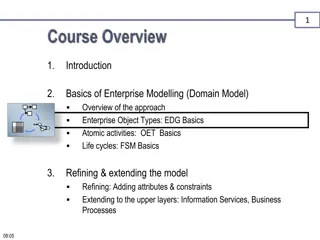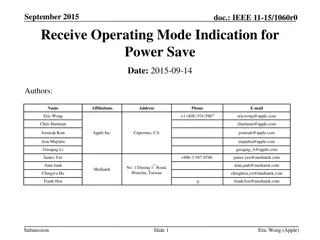Enterprise AP Power Save Mechanisms
This document discusses enterprise use cases and existing mechanisms for AP power save to reduce energy consumption and costs while maintaining network efficiency. Various strategies such as partial shutdown, radio configuration adjustments, and scheduled power save modes are explored.
Uploaded on Feb 26, 2025 | 0 Views
Download Presentation

Please find below an Image/Link to download the presentation.
The content on the website is provided AS IS for your information and personal use only. It may not be sold, licensed, or shared on other websites without obtaining consent from the author.If you encounter any issues during the download, it is possible that the publisher has removed the file from their server.
You are allowed to download the files provided on this website for personal or commercial use, subject to the condition that they are used lawfully. All files are the property of their respective owners.
The content on the website is provided AS IS for your information and personal use only. It may not be sold, licensed, or shared on other websites without obtaining consent from the author.
E N D
Presentation Transcript
April 2024 doc.: IEEE 802.11-24/659r1 Thoughts on AP Power Save Date: 2024-04-20 Authors: Name Binita Gupta Affiliations Cisco Systems Address San Diego, CA, USA Phone email binitag@cisco.com brianh@cisco.com Brian Hart Cisco Systems mmsmith@cisco.com Malcolm Smith Cisco Systems jerhenry@cisco.com Jerome Henry Cisco Systems juzuniga@cisco.com Juan Carlos Zuniga Cisco Systems Submission Slide 1 Binita Gupta et al (Cisco Systems)
April 2024 doc.: IEEE 802.11-24/659r1 Introduction UHR PAR has defined the goal of enabling AP power save (PS) This amendment provides a mechanism to reduce power consumption for Access Points (APs) (including mobile APs) and improved Peer-to-Peer (P2P) operation compared to the Extremely High Throughput MAC/ PHY operation. UHR PAR further highlights the need for AP power save Reducing power consumption of WLAN devices is required to prolong the battery life of untethered devices (e.g., non-AP STA, Mobile APs), reduce device cost, and lower energy bills of customers deploying non-AP and AP STAs in most scenarios (e.g., residential, enterprise, industrial, venues). Power saving mechanisms also decrease the carbon footprint of WLAN technology, reduce greenhouse gas emissions and conform to energy regulatory requirements worldwide. AP Power Save encompasses different scenarios, including periods of low utilization while minimizing the impact on the service. AP power save is increasingly becoming more important for enterprise deployments to reduce energy cost and help achieve sustainability goals. In this contribution we propose some considerations for AP power save with a focus on enterprise deployments. Submission Slide 2 Binita Gupta et al (Cisco Systems)
April 2024 doc.: IEEE 802.11-24/659r1 Enterprise AP Power Save Use Cases Enterprise customers like to schedule power save mode for APs during off peak hours, to reduce energy cost e.g. In an office from 7pm-7am In a bank from 6pm-8am In a stadium outside of operating hours NOTE: Cal 1 and Cal 2 define calendar profiles for AP power save During off-peak hours, enterprise networks can achieve AP power save by: powering down a subset of AP devices and still have other active APs (partial shutdown) Shutdown most AP radios and keep only one active radio- e.g. keep 2.4 GHz radio on, shutdown 5 and 6 GHz radios Lower NSS/BW operation for AP radios e.g. reconfigure all radios to operate as 1x1/20 MHz AP MLD devices are more power hungry due to multiple operating links, and hence AP power save becomes even more important Opportunistic AP PS is also important to consider for AP MLDs, besides PS operation during off-peak hours For MLD, power saving can be applied to affiliated APs or to entire AP MLD, e.g. one or more affiliated APs can be shutdown (or operate in low NSS/BW), instead of entire AP MLD still some other AP MLDs may be fully shutdown to save more energy Submission Slide 3 Binita Gupta et al (Cisco Systems)
April 2024 doc.: IEEE 802.11-24/659r1 Existing AP Power Save Mechanism Summary of potential existing AP power save mechanisms [1, 3]: Low capability mode operation for an AP (via reduced BW/NSS/MCS advertised in beacon) Disablement of one or more links of an AP MLD (using Advertised TTLM in 11be) AP Removal for specific link(s) of an AP MLD if affiliated AP goes into power save mode TWT based scheduled AP PS AP can set Responder PM bit to 1, and can be in doze state outside the TWT SPs Challenges to be addressed for AP power save for enterprise: As shown on previous slide, APs can enter power save based on off-peak hours schedule However, no mechanism is defined to advertise when and for how long an AP is in PS mode (start time, duration, periodicity, end time, PS mode operation in low capability etc.) and STAs do not know AP PS schedules This leads to suboptimal network operation during AP PS, since STAs can t take appropriate actions based on AP PS schedule, e.g. STA will continue to scan even when AP is shutdown, instead of stopping the scan Without knowing AP PS schedule, STA itself can t enter Doze state on the PS link This will lead to longer scanning delay, reduced throughput, roaming delays, QoS impact on flows etc. Submission Slide 4 Binita Gupta et al (Cisco Systems)
April 2024 doc.: IEEE 802.11-24/659r1 Requirements for AP Power Save Enterprise networks need to carefully consider multiple factors before enabling AP PS: Presence of legacy clients that do not support AP PS mechanisms Whether associated clients can be steered to nearby APs (e.g. using 11v BTM), or can operate on remaining links of an AP MLD (e.g. using TTLM or ML Reconfig add/delete links operation) Ensure QoS performance are met for associated STAs traffic and minimize KPIs impact Capabilities of associated clients (supported bands, MLO (EMLSR, STR), AP PS capable ) Historical stats (e.g. client arrival rate, client mix for unassociated clients, traffic volume etc.) AP power budget negotiated with the uplink switch AP power policy defining power budget utilization for different AP interfaces (Wi-Fi radios, Ethernet) Hence, AP PS opportunities in an enterprise network will vary based on the factors listed above Submission Slide 5 Binita Gupta et al (Cisco Systems)
April 2024 doc.: IEEE 802.11-24/659r1 Requirements for AP Power Save Accordingly, any AP power save mechanism should support: Periodic AP PS schedules as well as aperiodic/one-time AP PS schedule Dynamic updates to AP PS schedules as conditions change (e.g. amount and type of traffic, clients mix, number of clients, ) Announcing AP PS schedules to STAs in advance, for STAs to take appropriate actions AP PS schedules announcement should support signaling any options below: a) entire AP MLD is being put into power save/doze state, or b) subset of links of an AP MLD are put into power save/doze state, or c) some links of an AP MLD are entering into low capability mode operation (Static SM PS, Dynamic SM PS/EMLSR for AP) Cross-link advertisement of affiliated APs PS schedules, to enable STAs to learn PS schedules from any link of the AP MLD Recommending alternate links/AP MLDs with explicit AP power save indication, for STA to take appropriate actions Enable STAs to signal their preferred links among link(s) that are in AP PS mode Submission Slide 6 Binita Gupta et al (Cisco Systems)
April 2024 doc.: IEEE 802.11-24/659r1 Some Candidate UHR Proposals Previous contributions have discussed some candidate AP PS mechanisms: Scheduled AP Power save [1, 2, 3, 4] ON-OFF duty cycling of AP s operation Dynamic AP Power Save [1, 2, 3, 4] dynamic SM PS operation at the AP side Unscheduled AP Power Save [5, 6] keep one link of AP MLD active, and other links disabled Non-AP MLD sends wakeup request on active links to wake up APs in PS mode AP Power Save mechanism through adjustment of the AP s schedule & capability [7, 8] Different power states to support different power save levels and performance requirements Here we propose enhancements needed to address AP power save requirements captured on the previous slides Submission Slide 7 Binita Gupta et al (Cisco Systems)
April 2024 doc.: IEEE 802.11-24/659r1 Proposal: AP Power Save Announcement (1) An AP MLD needs to advertise its power save schedules and PS management mode for each PS schedule period in advance to support efficient AP PS operation STAs knowing the AP PS schedule can take appropriate actions: Operate on remaining links of the AP MLD, and doze on the PS link Transition to a a neighboring AP MLD that has desired links Indicate a preferred link among AP PS links We propose to define AP Power Save announcement (APSA), sent in advance in Beacon, Probe Response AP power save can apply for the entire MLD (when entire MLD is shutdown) or certain links of an AP MLD. APSA needs to be supported at the MLD level Can be announced through Reconfiguration ML element or a new AP Power Save ML element Enables advertising AP PS info at the MLD level as well as for individual affiliated APs level across all links e.g. entire AP MLD can go into Doze state or low capability PS mode, or subset of links can go into doze state Submission Slide 8 Binita Gupta et al (Cisco Systems)
April 2024 doc.: IEEE 802.11-24/659r1 Proposal: AP Power Save Announcement (2) AP Power Save announcement indicates: PS schedule: Start time, duration, interval (for periodic schedules), PS end time AP Power Management mode and Power State (see table) for each PS schedule Capability indication - NSS/BW/MCS for Static & Dynamic AP PS for each schedule APSA should support both short term (msec to seconds) and long term (minutes to hours) PS schedules, to meet various PS use cases If AP PS schedule applies to entire AP MLD, then AP PS info is provided for the entire MLD e.g. in Common Info of the ML element If entire AP MLD is going into full doze state/shutdown, then that AP PS schedule is announced for some time before AP MLD is shutdown For per-link AP PS, the PS info is provided per affiliated AP in the ML element AP PS mode of a link should be announced by other affiliated APs of the AP MLD, during the period when that link is in PS mode AP PS mode can also be indicated in RNR Changes to AP PS schedules should be reflected in the critical update flag AP Power Management Mode Power state Active mode Awake PS mode Dynamic AP PS state PS mode Static low capability state (Static AP PS) PS mode Full Doze state Submission Slide 9 Binita Gupta et al (Cisco Systems)
April 2024 doc.: IEEE 802.11-24/659r1 Proposal: Recommend Other APs during AP PS An AP MLD should take actions to ensure that any STAs associated on the AP/AP MLD that is transitioning to PS mode, has continued and optimal connectivity Pre-UHR STAs - AP MLD can use existing features (BTM, TTLM, ML Reconfiguration) to recommend and ensure STAs make use of other links/MLDs For pre-EHT STAs, send BTM Request to signal that AP s BSS will be terminated (if going into doze state). AP should indicate list of possible BSS transition candidates. For EHT STAs, for short term AP PS (e.g. msec-seconds), the corresponding AP link can be signaled as disabled for the AP PS duration (using advertised TTLM) For EHT STAs, for long term AP PS (e.g. minutes-hours), the corresponding AP can be signaled as being removed using ML Reconfiguration AP Removal feature BTM Request can also be sent to recommend other AP MLDs, or other active (non-PS) links of current AP MLD UHR STAs will learn about AP PS schedule from the AP PS announcement. BTM Request can be sent to recommend other AP MLDs. We propose to enhance BTM to provide AP Power Save indication e.g. in Request Mode or in a Reason Code field. UHR STAs will correlate information from APSA (PS schedule) and BTM to take appropriate actions. Submission Slide 10 Binita Gupta et al (Cisco Systems)
April 2024 doc.: IEEE 802.11-24/659r1 Proposal: Enable STAs to indicate Preferred Link(s) When an AP MLD is announcing AP PS schedules for one or more links, some associated STAs may prefer operating on those links e.g. if 6 GHz link is in AP PS (or going into PS), some associated STAs with LL traffic may prefer that link It would be beneficial for AP to know that certain STAs/non-AP MLDs prefer to operate on a link that is going into PS mode or is operating in PS mode A STA can signal its request for preferred link(s) among AP PS link(s): When sending SCS request, indicate preferred link(s) among PS links for that flow (in an optional subelement) When (re)associating, indicate preferred link(s) among PS links for its operation Using a new action frame to indicate preferred link(s) among PS links at other times Preferred Links info can indicate set of <link ID, desired PS state/capability> tuple for one or more links operating in the PS mode AP can then consider such requests from the STAs in its AP PS decision, to make any changes to its PS operation changes are reflected in updated AP PS schedules announced in beacon, probe response Submission Slide 11 Binita Gupta et al (Cisco Systems)
April 2024 doc.: IEEE 802.11-24/659r1 Conclusion We covered some AP power save use cases for enterprise networks We highlighted requirements that should be supported by the AP power save mechanism We presented three proposals to address AP power save requirements AP Power Save announcement (enable per MLD and per link level AP PS announcement) Recommending other APs/AP MLDS during AP PS (for legacy, EHT and UHR STAs) Enable STAs to indicate preferred link(s) among AP PS link(s) Submission Slide 12 Binita Gupta et al (Cisco Systems)
April 2024 doc.: IEEE 802.11-24/659r1 Straw Poll 1 Do you agree that an AP MLD can announce AP Power Save schedules in advance in beacon and probe response frames, for one or more affiliated APs or for the AP MLD? NOTE: mechanism for announcing AP power save schedule is TBD Submission Slide 13 Binita Gupta et al (Cisco Systems)
April 2024 doc.: IEEE 802.11-24/659r1 Straw Poll 2 Do you agree that a non-AP MLD can indicate its preferred links for operation among the links that are in AP PS mode or soon going into AP PS mode? Submission Slide 14 Binita Gupta et al (Cisco Systems)
April 2024 doc.: IEEE 802.11-24/659r1 References [1] Liwen Chu, et al., AP MLD power management, IEEE 802.11-23/0015r0, 2023 [2] Liwen Chu, et al., AP MLD Power save follow up, IEEE 802.11-23/1936r0, 2023 [3] Alfred Asterjadhi, et al., Considerations for enabling AP power save, IEEE 802.11-23/0010r0, 2023 [4] Alfred Asterjadhi, et al., Enabling AP power save_follow up, IEEE 802.11-23/2040r1, 2023 [5] Guogang Huang, et al., Considering Unscheduled AP Power Save, IEEE 802.11-23/0225r0, 2023 [6] Guogang Huang, et al., Enabling Unscheduled AP PS Follow-up, IEEE 802.11-23/0225r0, 2023 [7] Yongsen Ma, et al., AP Power Management, IEEE 802.11-23/1835r0, 2023 [8] Yongsen Ma, et al., AP Power Management Follow-up, IEEE 802.11-24/0097r0, 2024 Submission Slide 15 Binita Gupta et al (Cisco Systems)
